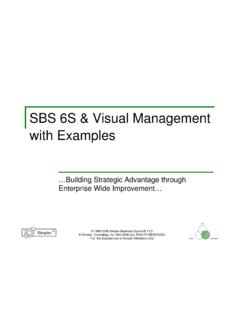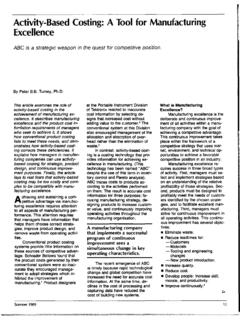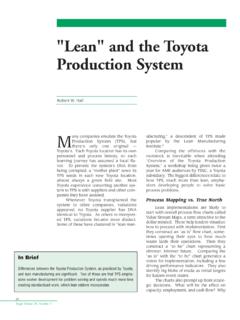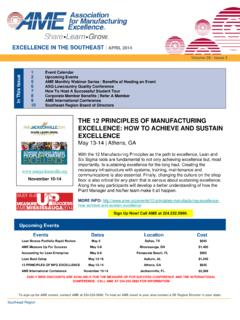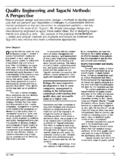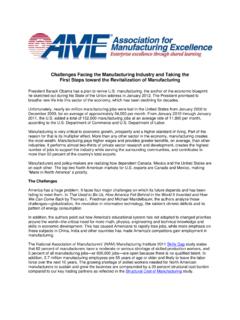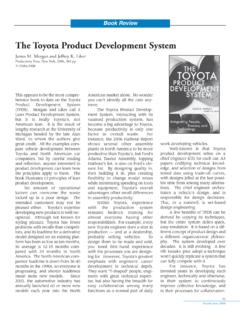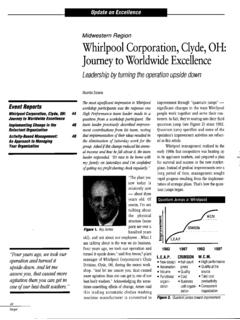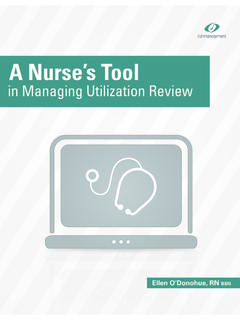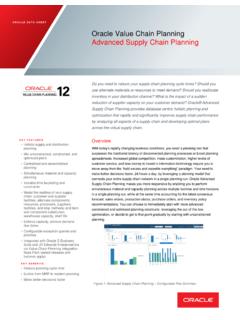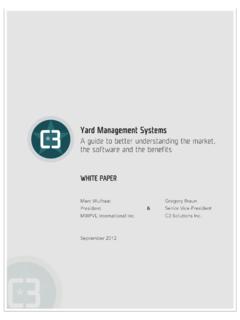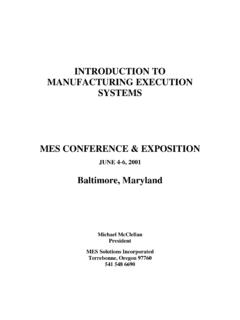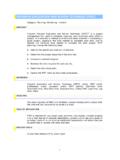Transcription of Crossdocking as a Supply Chain Strategy
1 Crossdocking as a SupplyChain StrategyBy reducing reliance on inventory buffers and expeditingcustomer orders, Crossdocking promotes a flow-throughsupply- Chain KulwiecCrossdocking as a distribution tacticis not new. However, its use con-tinues to grow with the popularityof just-in-time (JIT) methods, and as supplychain concepts such as collaboration takehold, and sophisticated information tech-nologies Crossdocking is pri-marily a warehousing practice, but inorder for it to be efficient and successful,there has to be close coordination andcontinuous, high-quality information flowamong manufacturer, distributor, and cus-tomer it is:A broad definition ofcrossdocking is the transfer of goods andmaterials from an inbound carrier to anoutbound carrier, without goods or prod-ucts actually entering the warehouse orbeing put away into storage. Thus, theproducts "cross the docks" from thereceiving dock area to the shipping dockarea.
2 Reality is a bit more complicatedthan this broad definition, since there areseveral versions of Crossdocking , asdescribed in the accompanying box,"Common Types of Crossdocking ." And itis clear that the shipper, typically the man-ufacturer, carries a high degree of respon-sibility for making Crossdocking at its cus-tomer (distributor) facilities can provide significantinventory savings. In its purest form, thereis no storage. Therefore, there is no rout-ing to storage areas, no subsequentretrieval from storage racks, and no re-routing back to dock areas. Both the costsof holding inventory and the costs of han-dling the inventory are eliminated or dras-tically reduced. In addition, crossdocking28 Target Volume 20, Number 3In BriefAuthor Ray Kulwiec explores Crossdocking as a means to improvesupply Chain performance. The article describes the Owens Corningapproach to Crossdocking , along with Sears and Wal-Mart will also find counsel on "when Crossdocking does anddoesn't apply.
3 " provides improved customer service byexpediting customer Corning's ApproachMost warehouses can crossdock atleast a portion of their incoming Corning, based in Toledo, OH,reports a range from a small percentage to40 percent to 50 percent, depending on thelocation. This manufacturer practices"opportunistic" Crossdocking , as well asdirect loading of outbound shipments fromthe production line. Opportunistic cross-docking takes "hot" items such as back-ordered or late-arriving goods and movesthem directly to outbound shipping areasinstead of moving them first to storageand putaway. Even if some of the neededgoods are in inventory, Crossdocking ofthe arriving items is performed to savetime and expedite orders. In some casesthe "hot" items are combined with prod-ucts coming directly off the productionline to make up outbound to Logistics SystemsDevelopment Team Leader BarryBurnham, Crossdocking at Owens Corningoccurs primarily at multi-purpose ware-houses co-located with the company'sproduction facilities.
4 They serve retail andwholesale facilities, and other company moves large, bulkymaterials such as fiberglass insulation,pallets of glass reinforcements, and vinylsiding. Efficiency of material movement isa major concern. By reducing the numberof "touches" applied to materials, the com-pany has experienced substantial reduc-tions in labor, product damage, and states that crossdockingis performed exclusively for palletized orotherwise unitized loads. Turns for mostcrossdocked items average 25 to 50 they are finished is not applied to materialscoming off the production line that havecuring or quality testing Issue 2004 Common Types of CrossdockingSeveral types of Crossdocking can be practiced, as follows:Full pallet load operation:This simplest, and usually least costly, version involves receiving an incoming load that ismarked and separated by outgoing orders. The pallet loads are simply sorted and re-routed into outgoing trucks hav-ing different classic example can be found in a less-than-truckload (LTL) truck terminal, where prod-ucts never touch the floor, but move directly from one truck to order makeup:In this version merchandise arrives at the dock sorted and marked by stock-keeping units(SKUs).
5 However, the goods must be segregated by customer order, generally requiring that pallet loads be brokendown. Cases may then be re-palletized and the new loads delivered to appropriate outbound Crossdocking :In some cases materials in storage at the warehouse are blended in with incoming materials,and these newly completed palletized orders are then routed to outbound trucks. Likewise, some of the incominggoods may be routed to temporary storage in the warehouse instead of all being crossdocked. (See Figure 5.)Opportunistic Crossdocking : "Hot" items, such as late-arriving products on back order, are often crossdocked ratherthan being placed in inventory and order-picked. Such goods may be crossdocked directly upon receipt, or combinedwith items from storage. The operation can be vital in enhancing customer consolidation:Products may sometimes come in by both truck and rail, and need to be consolidated inorder to complete customer orders. Here the goods are combined and sorted for shipment within 24 to 48 hours.
6 Arelated tactic is pool-car forwarding. Here, goods are picked up by truck and transferred to a rail boxcar at the ship-ping origin point. Then, at the rail destination, the goods are unloaded and transferred back into trucks for storage:Promotional or seasonal merchandise, or awkward, bulky items, may be stored temporarily off-site, or in a yard trailer, until just before shipment, when they are moved to the cross-docking area. This approachworks well for a space-limited warehouse, or where warehouse handling may be extremely tedious and many locations, received items arecombined with goods carried to the dockarea in ware carts. Picking is done from thecarts to make up outbound loads that alsocontain received materials. This "compro-mise" solution provides flexibility and saveson transportation and handling to and fromtraditional storage areas in the Owens Corning, various levels ofinformation systems support crossdockingas well as other warehouse include enterprise resource planning(ERP) software, warehouse managementsystems (WMS), yard management systems(YMS), radio-frequency data communica-tion (RFDC), and bar coding.
7 Line loadingfrom production has been practiced for sev-eral years. Opportunistic Crossdocking hasbeen mostly implemented as the WMS andYMS software systems have been Supply Chain IssueCrossdocking today is a Supply -chainissue, requiring collaboration among mem-bers of the Chain . In fact, says Toronto-based management and logistics consult-ant Dave Luton, Crossdocking in an era of30 Target Volume 20, Number 3 Translation of the AcronymsCrossdocking is an important element in a synchronized Supply Chain . In turn, Supply Chain management todayrelies on the use of various information technologies and techniques whose acronyms have become an "alphabetsoup." Brief explanations of the acronyms are provided:ASNA dvance ship electronic notification that a product is due, before it is receivedERPE nterprise resources planningLTLLess-than-truckload quantity for shipmentOMSO rder management cross between planning and executionsoftware.
8 OMS performs order entry, inventory management, order processing, and customer service. It prepares the shipping and delivery execution program, which is then transferred to a warehouse management of saleRFDCR adio frequency data communicationSCMS upply Chain management. The process of optimizing the flow of materials and products from the supplier's supplier to the customer's management execution software system that plans freight movement, oversees freight rating, selects the route and carrier, and manages freight bills and managed process in which the vendor assumes responsibility for replenishing the customer's stock as Warehouse management execution system that manages the operations or a warehouse or distribution center, including receiving, Crossdocking , putaway, inventory control, order picking, replenishment, packing, and management execution system that manages yard operations, including receipt of carriers, dock scheduling and spotting, and operator activities relating to receiving and inventories is the element thatlinks the Supply and demand sides of notes that market forces arecontinuously increasing pressure on supplychain management (SCM)
9 Performance, withrequirements for 1) increased throughputwith lower inventories, 2) more product lineswith lower operational costs, and 3) morevalue-added services provided to the past, says Luton, the traditionalSCM model relied on the use of inventorybuffers at strategic points within the supplychain to alleviate the uncertainty betweensupply and demand (see Figure 1). Notethat in this example the Supply and demandchains are de-coupled, and inventorybuffers are used to provide a connectinglink. Today, however, the objective is tosynchronize the Supply and demand chains(Figure 2) to provide flow-through opera-tion made possible by Crossdocking . In thismodel, the chains are coupled, and cross-docking replaces inventory buffering as thelinking Supply - Chain reliability iscritical when operating with minimalinventory buffers. (If product does notarrive from the supplier on time, there is lit-tle contingency in the inventory buffers.
10 Therefore, information sharing is considering the role ofadvanced information technologies, look ata simple and basic information technique labeling. The easiest labeling scenario iswhen stretch-wrapped pallet loads travelintact to the ultimate destination. Sinceeach case in the load does not have to beidentified, only the pallet requires identifi-cation, on two faces if theother hand, incoming pallet loads that haveto be broken down will require labeling ofindividual cases or items, and the numberof pieces to each consignee becomes more compli-cated when less-than-full-case situationsare involved. Unpacking, picking, packing,and labeling obviously are more time con-suming. Some distributors choose not tocrossdock less-than-full-case the KeyInformation sharing and collaborationamong trading partners are critical for suc-cessful Crossdocking which, in turn, pro-vides the means for Supply - Chain synchro-nization.
